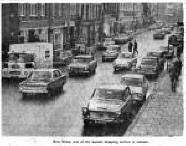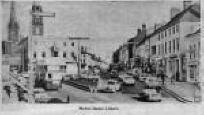
A LONG AND CHEQUERED HISTORY

Entering the seventies with a prosperous population approaching 24,000, the thriving Borough of Lisburn can look back on a long and chequered history in which the sort of peaceful prosperity brought by the Huguenot linen experts alternated with occasional rebellious sackings of the whole town.
Incidents in its history have been recorded since the reign of the first Queen Elizabeth. It has been under siege, has witnessed massacre on a large scale, has been razed to the ground twice by disastrous fires, but has always risen again to continue on its path of steady progress engendered by the inherent quality of its people.
 In the early years of the 17th century, long before the
thriving modern town that is Lisburn to-day was even thought
of, there stood on the same site a tiny village called
Lisnagarvagh.
In the early years of the 17th century, long before the
thriving modern town that is Lisburn to-day was even thought
of, there stood on the same site a tiny village called
Lisnagarvagh.
It was a stronghold of the O'Neills, a popular and powerful dynasty which stood firm against the armies and the subtleties of Queen Elizabeth until death removed her from the scene.
The land owned by the O'Neills and other earls later passed into the ownership of Sir Fulke Conway, an officer in the. English Army, and about two centuries later Sir Richard Wallace became Member of Parliament for Lisburn.
The memory of these two benefactors is perpetuated. in such place names as Conway Street and Wallace Park and even Conway House Hotel, just outside the town, which was the former home of a more recent benefactor, linen magnate Sir Milne Barbour
The origins of the change of name from Lisnagarvagh to Lisnagarvey and later to Lisburn are shrouded in, mystery. Some historians think the present name was chosen because the town was burned by insurgents. Others that it originated from a place known as Louzy Burne, where the insurgents forced an entry into the. town.
When Louis XIV of France revoked the Edict of Nante in 1685 many thousands of French Protestants sought refuge outside their own country, and about 6,000 of them fled to Ireland. A large number settled in and around Lisburn where, because many of them were experts in the manufacture of silk and fine linen, they gave so much impetus to the local linen industry that it soon became one of the most important and prosperous trades in the district. Some of the refugees brought with them finer skills and better techniques than were being used in Ireland at the time.
For more than a century these Huguenots lived as a separate French community, although their descendants, through mixed marriages were becoming assimilated into the local community life, inheriting the skill and the character of their French forebears.
This was really the beginning of Lisburn's prosperity, and it lasted until 1707, when the town was almost completely destroyed by fire. The cathedral and Lord Conway's castle were destroyed, and while the cathedral was rebuilt almost immediately, all that remains of the castle is part of the surrounding wall and its gateway.
The most significant date in the recent history of the town is March 24, 1964, for on that day Lisburn was created a Municipal Borough by the granting of a Charter of Incorporation by the Second Queen Elizabeth.
Apart from the. usual rejoicings the occasion was marked by the presentation of a mayoral chain by the Linen Thread Company (now Barbour's Threads): a deputy mayor's chain by the trade unions; a silver mace by the Northern Bank, official treasurer of the new Borough. and robes for the members of the Borough Council by the local Chamber of Commerce.
Ulster Star
24/01/1970
